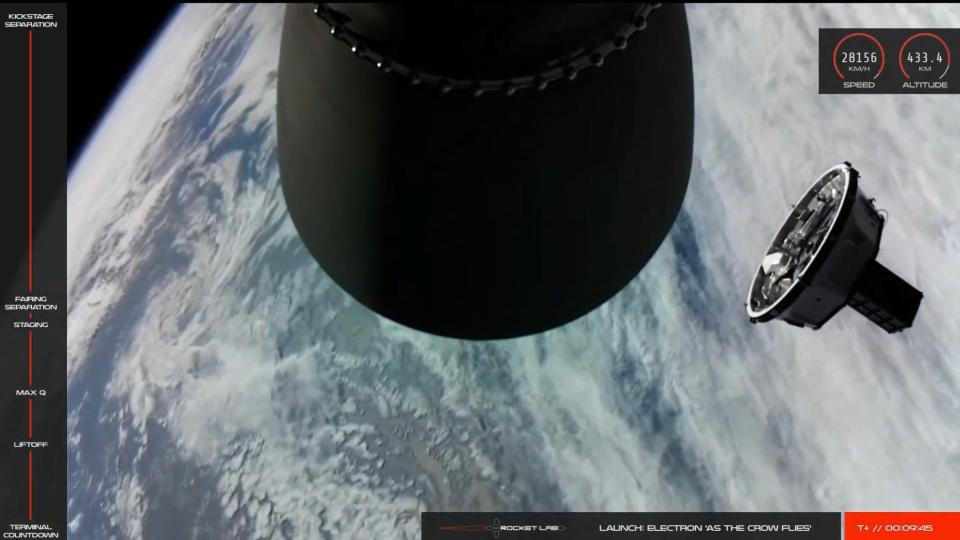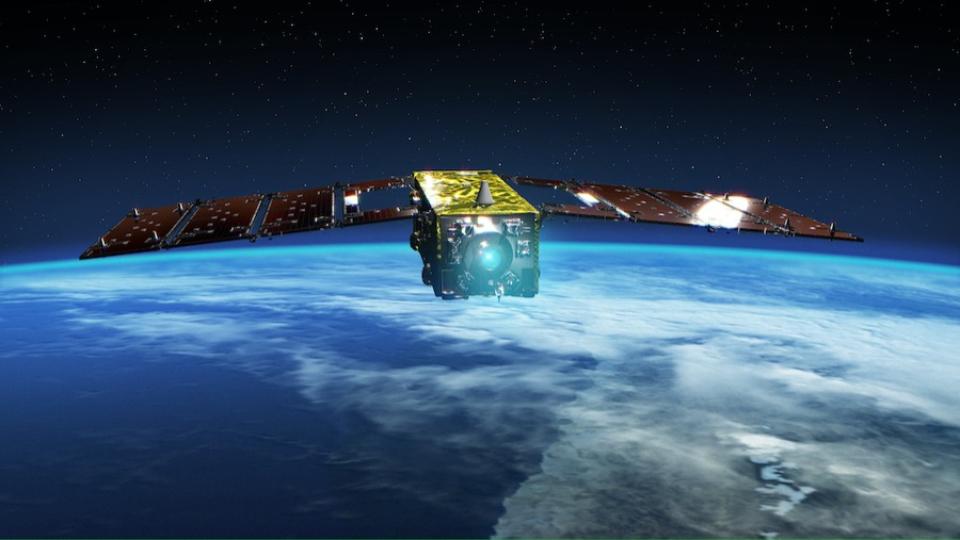Hello, and welcome to the Daily Space for today October 23, 2019. I am your host Annie Wilson. Most Mondays through Fridays, either I or my co-host Dr Pamela Gay will be here bringing you a quick rundown of all that is new in space and astronomy.
———————
Today we have two technology demonstrations and a Japanese satellite re-entry. On October 17, 2019 at 1:22 AM (UTC), Rocket Lab launched the “As The Crow Flies” mission on an Electron rocket.

Before we talk about the launch, let’s check out their launch patch.
The launch patch for “As The Crow Flies” features 6 stars, one of which has 9 points. Four of these 6 stars are white and the remaining two are blue. An outline of a satellite with an orbit path is superimposed upon the Earth, which sits behind a mountain range or rocky outcrop.
As far as symbolism goes, I’m fairly certain that the satellite outline represents the payload for this mission. The 9 pointed star is probably a reference to the fact that this is Rocket Lab’s 9th launch. Astro Digital, the customer, currently has 6 satellites in orbit, so I’m going to take a leap of faith and assume that’s what each star represents.
This was only the second time that Rocket Lab had a sole passenger on a launch. So, what was the passenger?

Everyday Astronaut captured a screenshot of the launch broadcast which shows the Kick Stage with a big black box on it. That big black box is Palisade, a 16 unit CubeSat developed and built by Astro Digital. Palisade is meant to be a technology demonstration. Other than that, there’s been no public statements on the purpose.
- Super cool view from @RocketLab’s launch tonight from stage two offering a beautiful view of their kick stage after stage separation. (Twitter)
- Palisade 16U CubeSat (Gunter’s Space Page)
I would like to note that Palisade does strongly resemble Astro Digital’s Corvus-16 arrangement. That’s not highly unusual since the whole concept of the Corvus Platform is to provide cost-efficient and flexible options for Astro Digital’s customers.
- Landmapper-HD 1, …, 20 (Corvus-HD 1, …, 20) (Gunter’s Space Page)
- AS THE CROW FLIES (RocketlabUSA)
- Astrodigital Systems
Next up: China launched a Long March 3B rocket carrying the TJSW-4 mission on October 17th at 3:21 PM (UTC).
TJSW-4 is the fourth of a series of experimental satellites and is probably destined for a geostationary orbit.

While we don’t know the exact nature of this satellite, China claims it is a technology demonstration of multi-band, high speed communication techniques. The lack of public information about this particular satellite and the others in the TJSW series may mean that it is intended for military use.
- A China Long March 3B rocket launched the TJSW-4 mission on Thursday, October 17, 2019 at 3:21 PM (UTC). (Rocketlaunch.Live)
- TJS 4 (Gunter’s Space Page)
A nighttime photo taken by Guo Wenbin of the Long March 3B liftoff is visually stunning with the yellows, oranges and reds of the exhaust plume at the moment of launch. This gorgeous display is due to the *highly toxic* dinitrogen tetraoxide and unsymmetrical dimethylhydrazine used as fuel in the strap-on boosters, first and second stages. (The third stage uses liquid hydrogen and liquid oxygen.) So, if these two materials are highly toxic, why are they used as fuel? Quite simply, as long as the two don’t touch, they can be stored for quite some time without the use of any special cooling or pressurization systems — much like solid fuel.
- Long March 3B (Wikipedia)
- Unsymmetrical dimethylhydrazine (Wikipedia)
- Dinitrogen tetroxide (Wikipedia)
JAXA Satellite re-enters Earth’s atmosphere after experiments testing the limits of ultra-low orbits.
The Japanese Space Agency, JAXA, recently announced that the Tsubame satellite – also known as “SLATS” (which stands for Super Low Altitude Test Satellite) – de-orbited on October 2nd, ending an almost three-year mission which tested the ability of an Earth-imaging camera to operate at very low altitudes. The xenon-fueled ion engine helped the satellite to stay aloft despite aerodynamic drag, which JAXA states can be “approximately 1,000 times greater than that of most Earth observation satellites at an altitude of 600 to 800 km.” The satellite launched aboard an H-2A rocket on December 23rd of 2017; both craft & rocket were designed & built by Mitsubishi Heavy Industries corporation.

Tsubame, which means “barn swallow,” was able to maintain useful attitude & altitude despite encountering drag forces which usually cause objects to quickly de-orbit and burn up due to atmospheric friction. After being placed into an initial elliptical orbit with a perigee (or low point) of around 392 km above the Earth, JAXA controllers at first allowed the satellite to be lowered gradually by the atmosphere to a more circular orbit at 271 km. The satellite was then able to use its low-thrust xenon-fueled electric engine to stabilize at that altitude for about a month before shutting the engine off to allow the satellite’s orbit to gradually decay to lower & lower orbits.
The satellite was able to maintain each of these successive lower orbits with its low-thrust engine, and did so for about a week at each altitude before allowing the atmosphere to take over once again. At 167 km above the Earth, the craft was forced to use its liquid fueled main engine in conjunction w/the ion thruster to maintain the orbit, and JAXA reports that it de-orbited after completing all of its scheduled experiments.
In addition to testing technologies designed to enable the potential economic & operational benefits of being able to launch smaller satellites to lower orbits, using less expensive sensor suites (potentially on less expensive payload deployment systems!), JAXA also tested a special coating designed to combat the effects of atomic oxygen (rather than typical O2), which is known to damage the materials which typically coat the outer surfaces of satellites. According to JAXA, “For SLATS, countermeasures have been taken such as applying a coating which is highly resistant to atomic oxygen to the outer surface of the multi-layer insulation. SLATS is also equipped with an atomic oxygen monitoring system which measures the concentration of atomic oxygen and the deterioration of materials when reacting with atomic oxygen. The acquired data will be used in the design of future super low altitude satellites.”
- Japanese satellite re-enters atmosphere after experiments in ultra-low orbit (Spaceflight.now)
- About Super Low Altitude Test Satellite “TSUBAME” (SLATS) (JAXA)
- SLATS:Super Low Altitude Test Satellite (JAXA)
———————
That rounds out our show for today.
Thank you all for listening. The Daily Space is produced by Susie Murph, and is a product of the Planetary Science Institute, a 501(c)3 non profit dedicated to exploring our Solar System and beyond. We are made possible through the generous contributions of people like you. If you would like to learn more, please check us out on patreon.com/cosmoquestx
Each live episode of the Daily Space is archived on YouTube. If you miss an episode here on Twitch.tv, you can find it later on youtube.com/c/cosmoquest. These episodes are edited and produced by Susie Murph.
We are here thanks to the generous contributions of people like you who allow us to pay our staff a living wage. Every bit, every sub, and every dollar committed on Patreon.com/cosmoquestx really helps. If you can’t give financially, we really do understand, and there are other ways you can help our programs. Right now, the best way you can help is to get the word out. Let you friends know, share our channel to your social media, or leave a recommendation. You never know what doors you are opening.
We really wouldn’t be here without you – thank you for all that you do.


 We record most shows live, on Twitch. Follow us today to get alerts when we go live.
We record most shows live, on Twitch. Follow us today to get alerts when we go live.